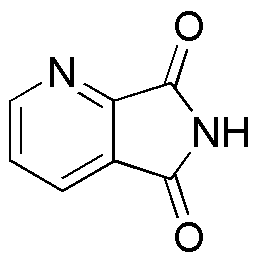Quinolinimide is widely utilized in research focused on:
- Organic Electronics: This compound is used in the development of organic light-emitting diodes (OLEDs) and organic photovoltaic cells, enhancing energy efficiency and performance in electronic devices.
- Fluorescent Probes: Quinolinimide derivatives serve as fluorescent probes in biological imaging, allowing researchers to visualize cellular processes with high specificity and sensitivity.
- Pharmaceutical Development: The compound is explored for its potential in drug design, particularly in targeting cancer cells, due to its ability to interact with specific biological pathways.
- Polymer Chemistry: It is incorporated into polymer matrices to improve mechanical properties and thermal stability, making it valuable in the production of advanced materials.
- Photochemical Applications: Quinolinimide is utilized in photochemical reactions, aiding in the synthesis of complex organic molecules, which is crucial for various industrial applications.
General Information
Properties
Safety and Regulations
Applications
Quinolinimide is widely utilized in research focused on:
- Organic Electronics: This compound is used in the development of organic light-emitting diodes (OLEDs) and organic photovoltaic cells, enhancing energy efficiency and performance in electronic devices.
- Fluorescent Probes: Quinolinimide derivatives serve as fluorescent probes in biological imaging, allowing researchers to visualize cellular processes with high specificity and sensitivity.
- Pharmaceutical Development: The compound is explored for its potential in drug design, particularly in targeting cancer cells, due to its ability to interact with specific biological pathways.
- Polymer Chemistry: It is incorporated into polymer matrices to improve mechanical properties and thermal stability, making it valuable in the production of advanced materials.
- Photochemical Applications: Quinolinimide is utilized in photochemical reactions, aiding in the synthesis of complex organic molecules, which is crucial for various industrial applications.
Documents
Safety Data Sheets (SDS)
The SDS provides comprehensive safety information on handling, storage, and disposal of the product.
Product Specification (PS)
The PS provides a comprehensive breakdown of the product’s properties, including chemical composition, physical state, purity, and storage requirements. It also details acceptable quality ranges and the product's intended applications.
Certificates of Analysis (COA)
Search for Certificates of Analysis (COA) by entering the products Lot Number. Lot and Batch Numbers can be found on a product’s label following the words ‘Lot’ or ‘Batch’.
*Catalog Number
*Lot Number
Certificates Of Origin (COO)
This COO confirms the country where the product was manufactured, and also details the materials and components used in it and whether it is derived from natural, synthetic, or other specific sources. This certificate may be required for customs, trade, and regulatory compliance.
*Catalog Number
*Lot Number
Safety Data Sheets (SDS)
The SDS provides comprehensive safety information on handling, storage, and disposal of the product.
DownloadProduct Specification (PS)
The PS provides a comprehensive breakdown of the product’s properties, including chemical composition, physical state, purity, and storage requirements. It also details acceptable quality ranges and the product's intended applications.
DownloadCertificates of Analysis (COA)
Search for Certificates of Analysis (COA) by entering the products Lot Number. Lot and Batch Numbers can be found on a product’s label following the words ‘Lot’ or ‘Batch’.
*Catalog Number
*Lot Number
Certificates Of Origin (COO)
This COO confirms the country where the product was manufactured, and also details the materials and components used in it and whether it is derived from natural, synthetic, or other specific sources. This certificate may be required for customs, trade, and regulatory compliance.


